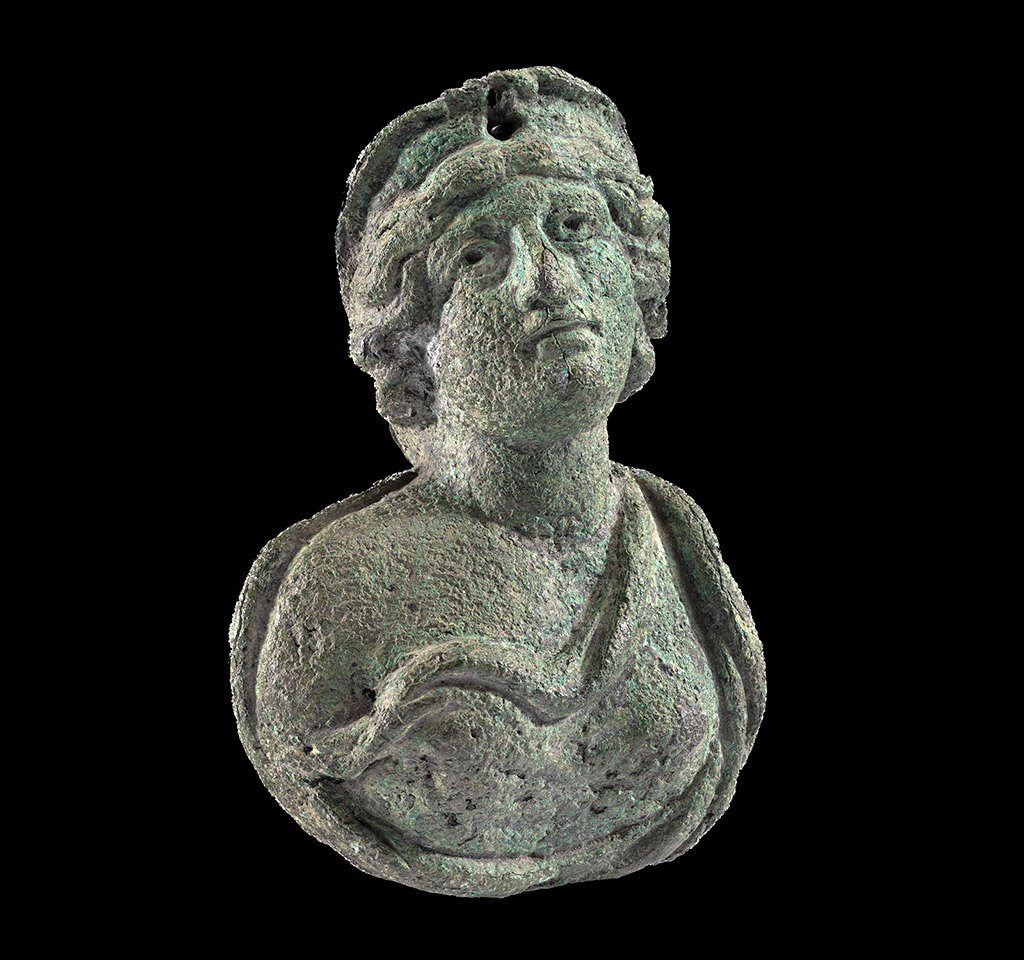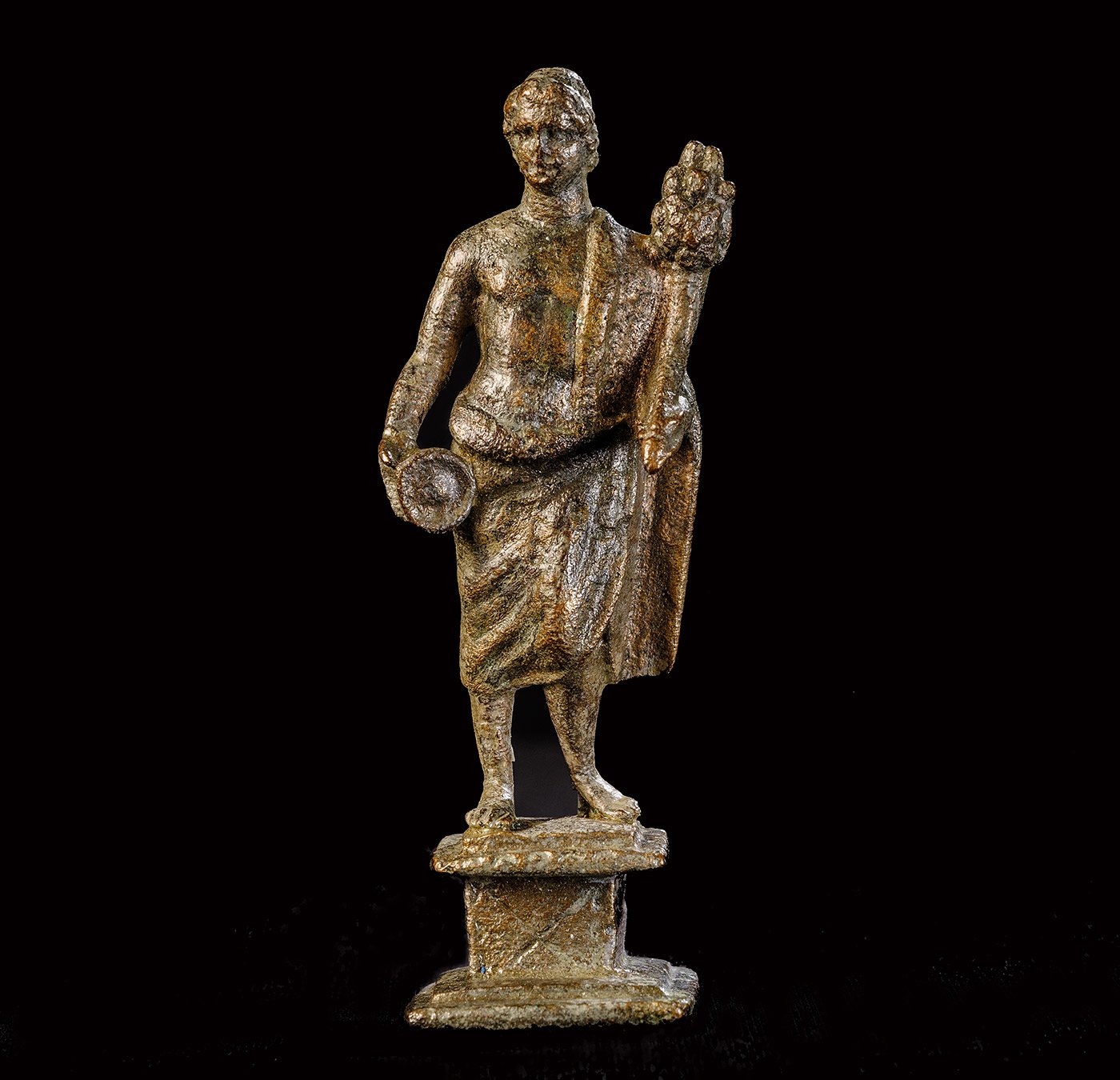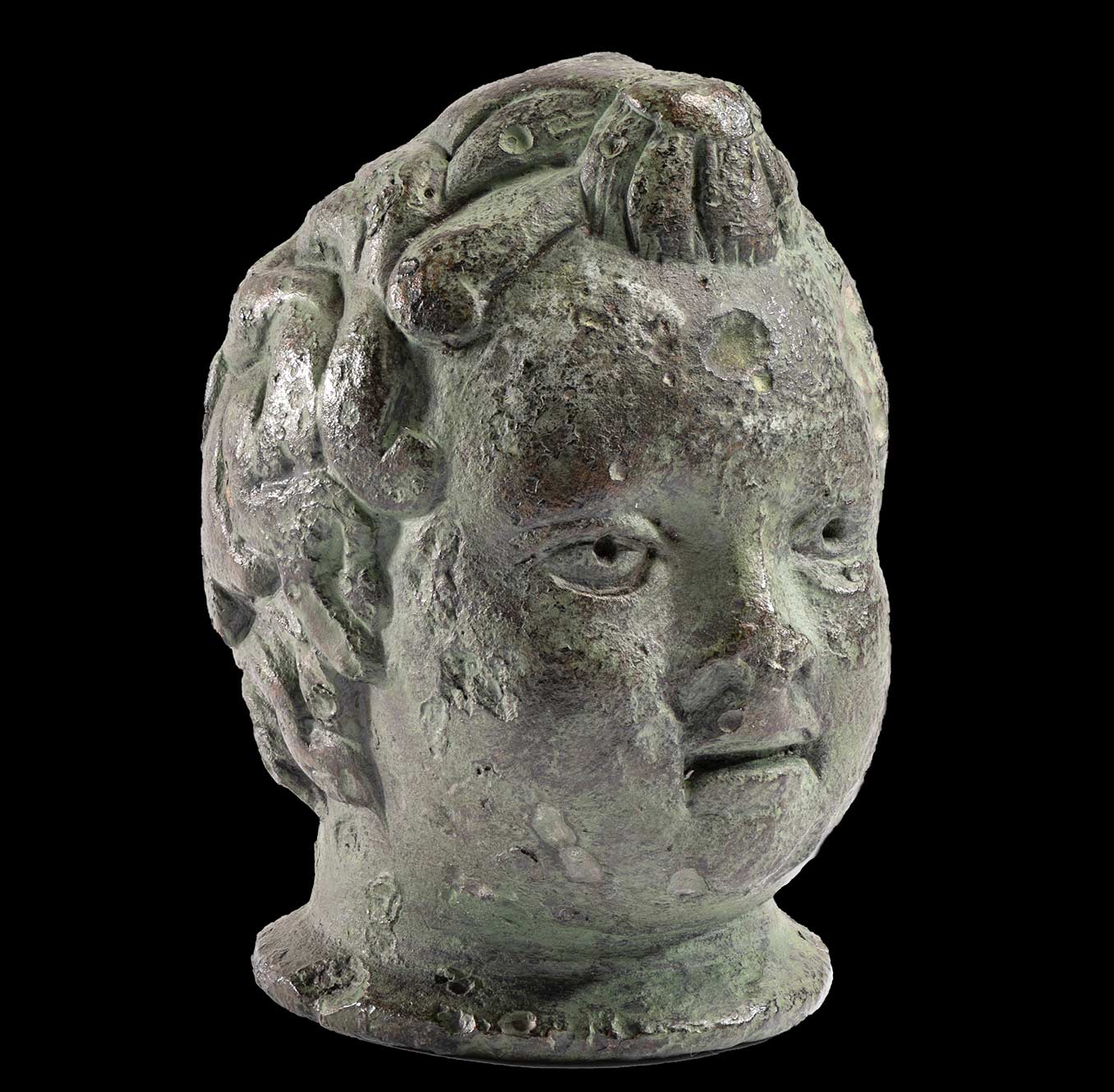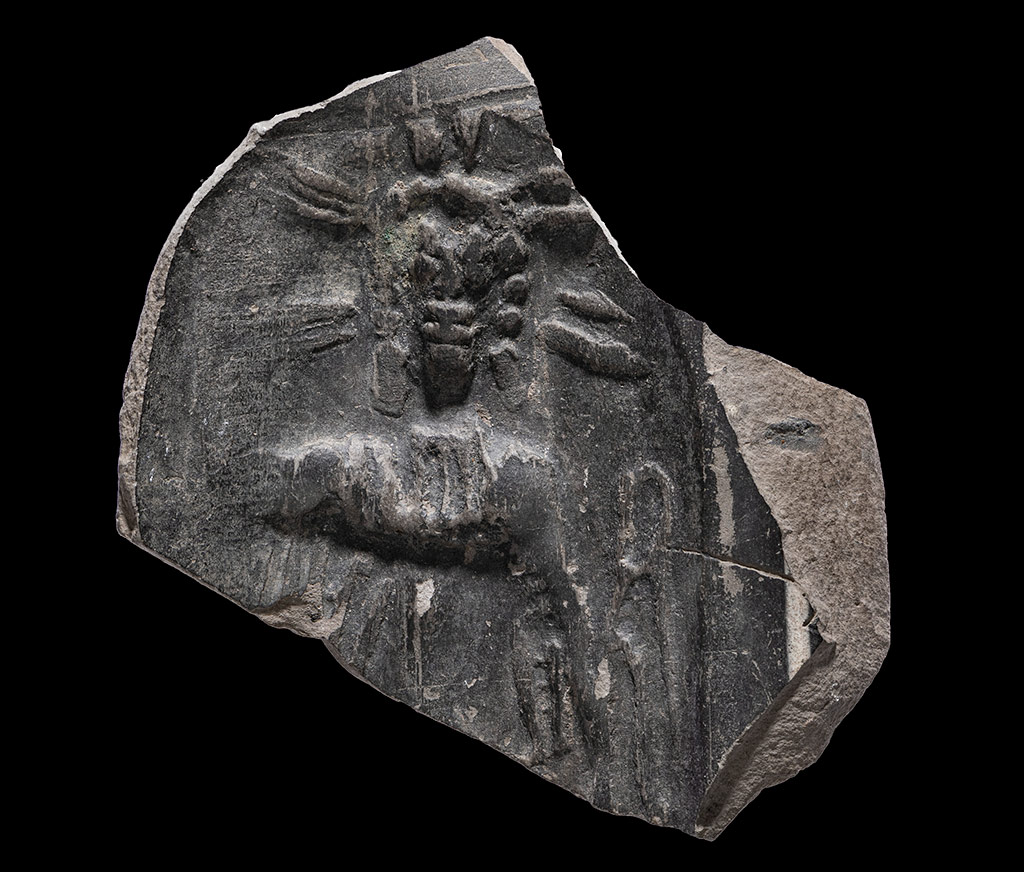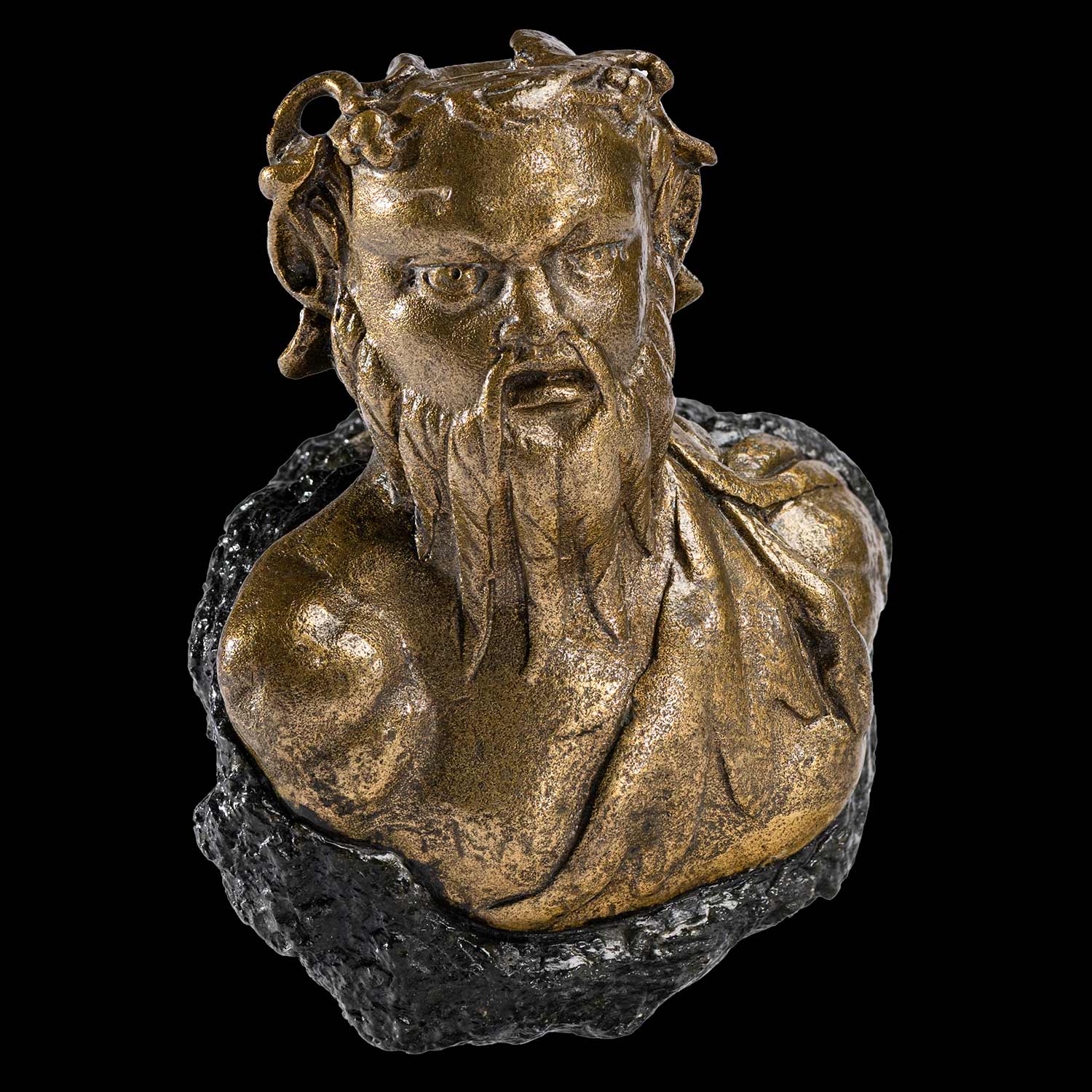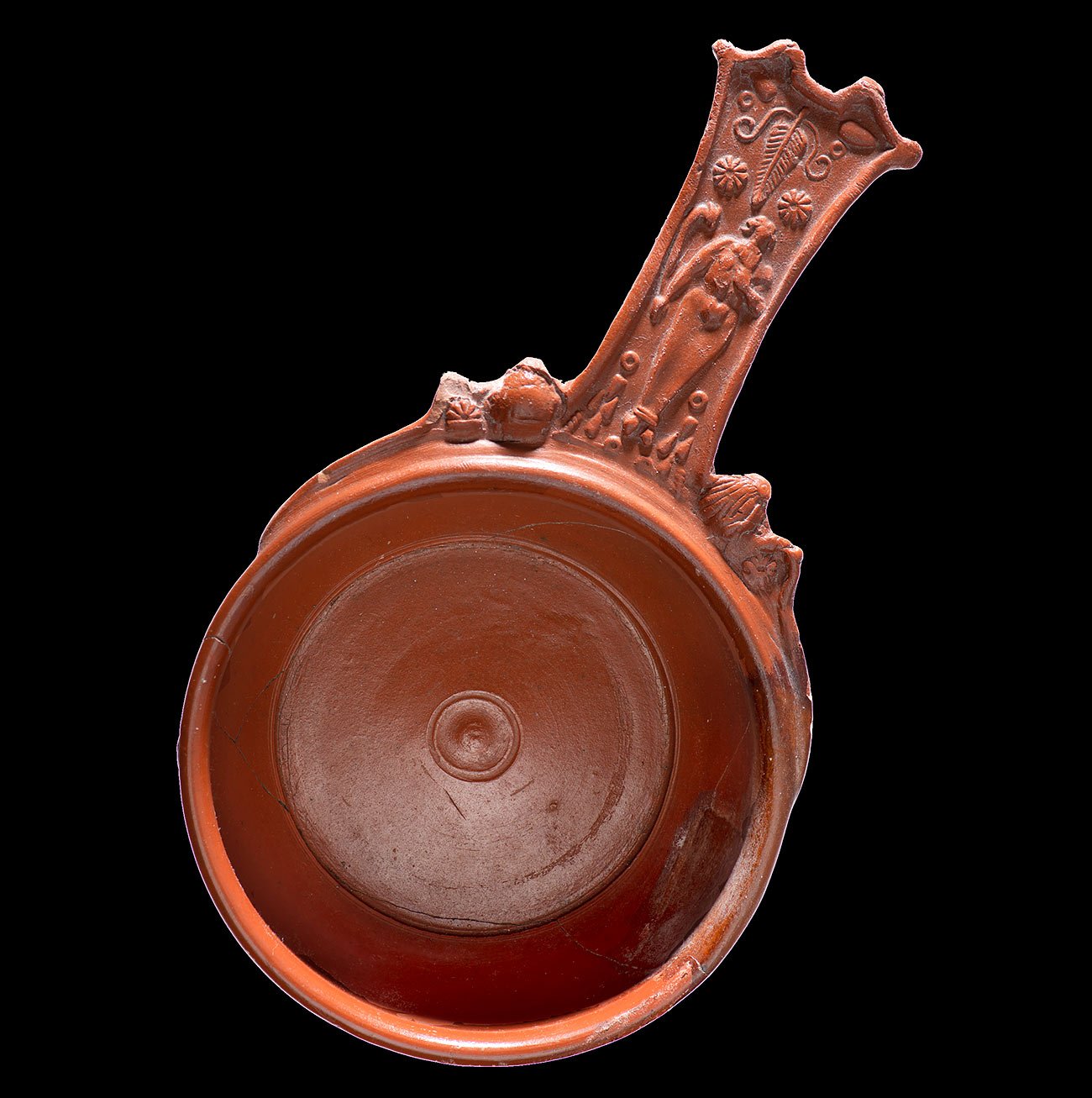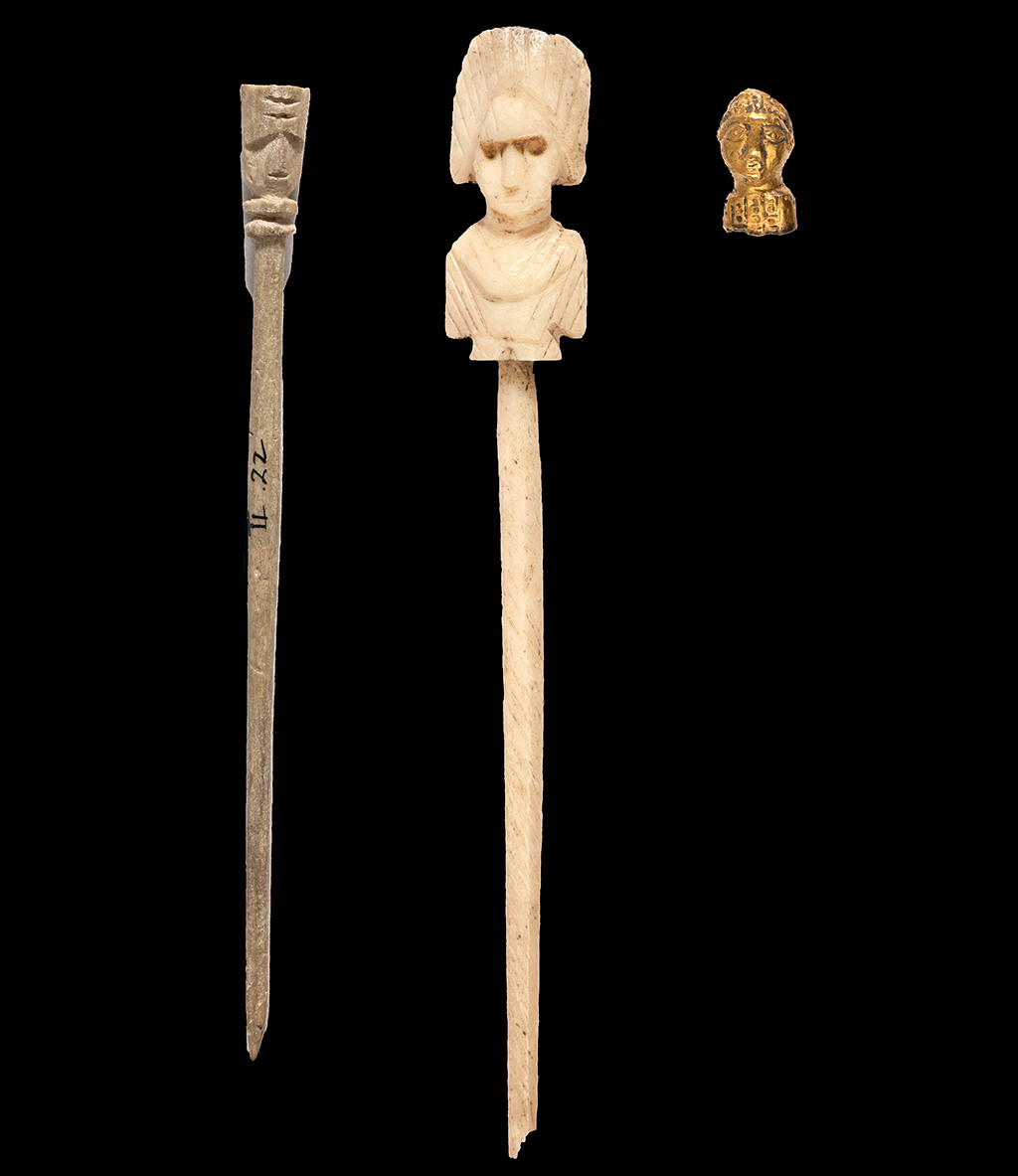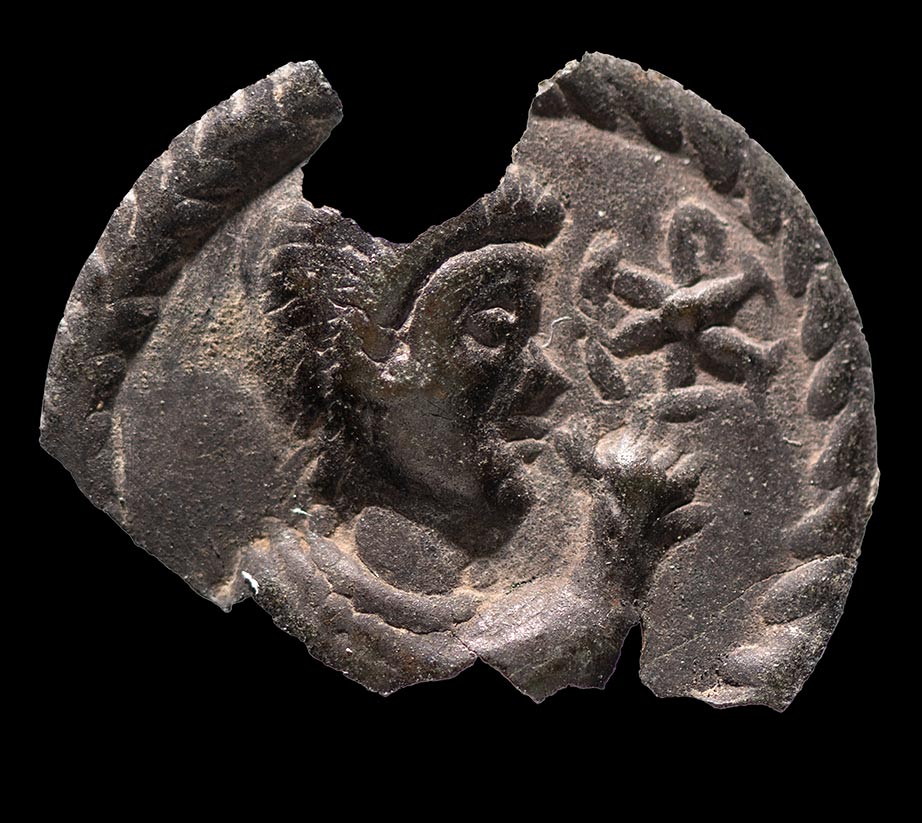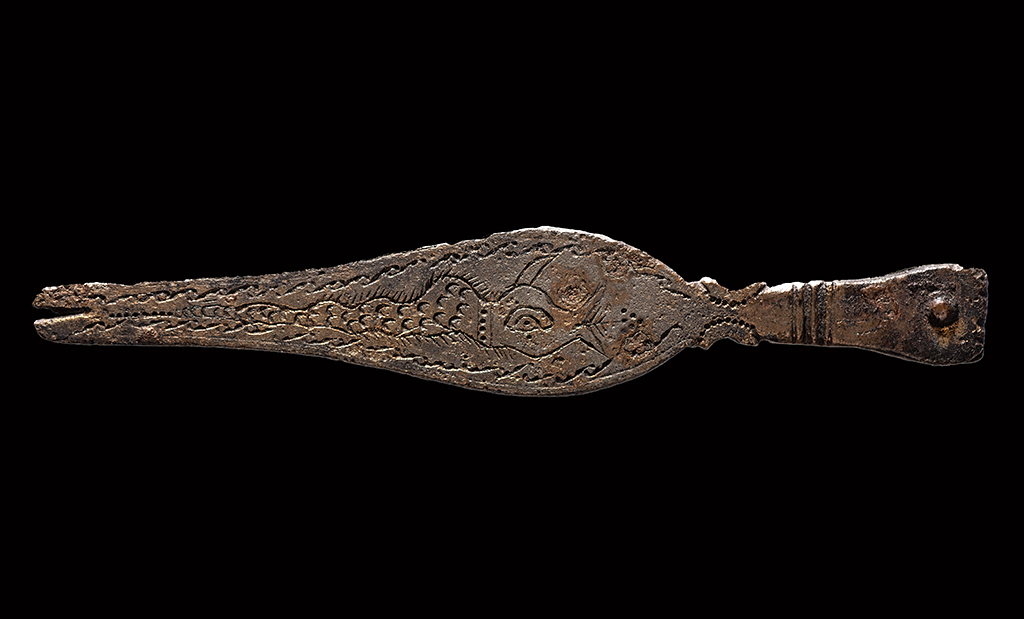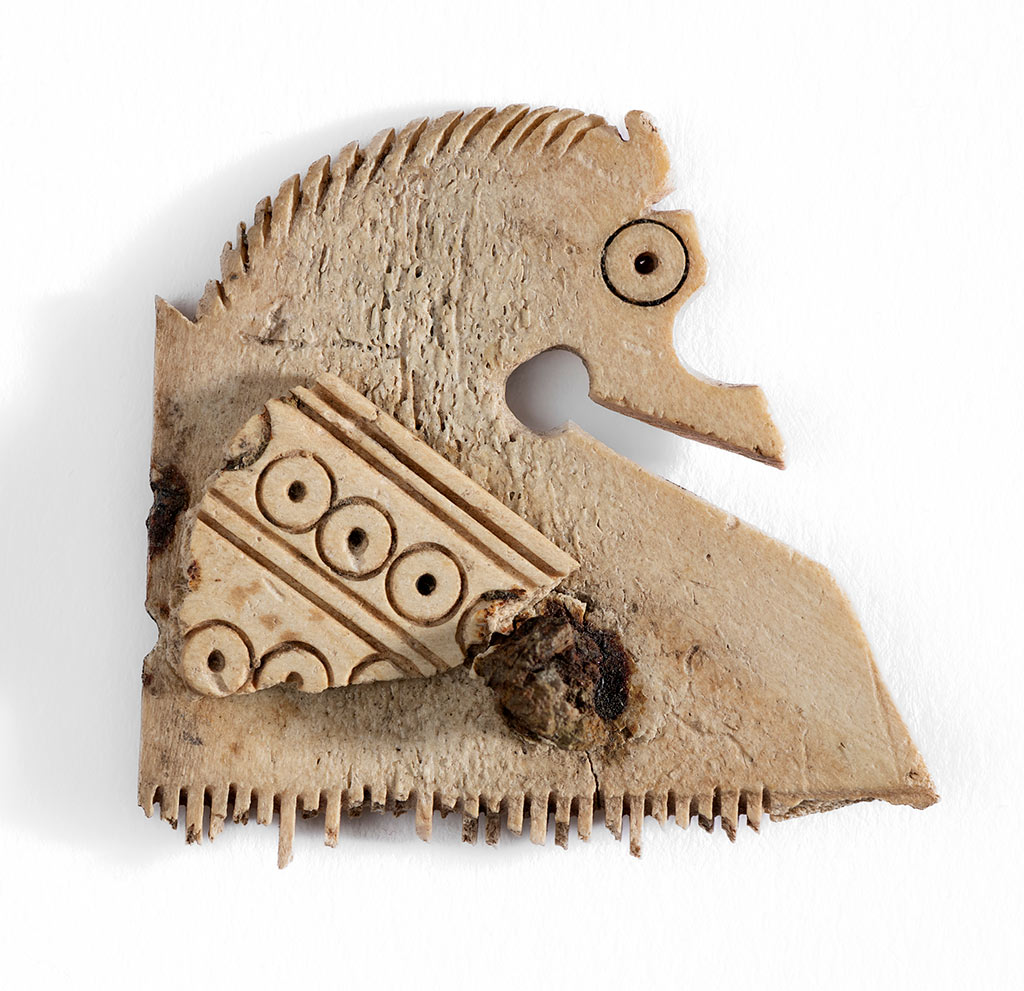Minerva
The best-known face on display at Richborough is that of Minerva. She was one of the 12 main Roman deities and equated to the Greek goddess Athena. The goddess of wisdom, strategy in war, and the arts, she was also associated with crafts and trade. It is in this last role that she appears here, as a steelyard weight used to measure items for trade.
The figure was cast from copper alloy, with a hollow back that was filled with lead to create the desired weight. Under magnification it is possible to see fine scratch marks across the back of the lead section that read ‘Aviti’. Perhaps this was the owner’s name.
Other than a slightly flattened nose, and the patina which has turned the surface green, the weight is in perfect condition. It was made sometime in the 2nd century AD on the continent, and imported to Britain.
View in 3DBonus Eventus
In classical religion Bonus Eventus (which translates as ‘good outcome’) was a deity associated with agriculture and with a general concept of success. He commonly appears on intaglios (small insets) in rings as well as on coins, and seems to have been called on for protection. Unlike Minerva, he does not have a significant role within myth, so he is not well known today despite the many images of him that survive.
This statuette would have been a votive offering at a shrine, possibly within a private home. It depicts Bonus Eventus as a young man with a cloak over one shoulder and arm. In his right hand he holds a patera (a shallow dish for pouring offerings of wine during prayer) and in his left hand a cornucopia – a horn overflowing with food, a symbol of abundance.
The statuette is well preserved and retains a good amount of fine detail, such as the curls of the hair. Its artistic style shows that it was made on the continent in the late 1st to early 2nd century, and imported to Britain.
View in 3DHarpocrates
It is well known that the Romans took on many aspects of Greek mythology and religion. But they did the same with religions from other parts of their empire too. This weight is in the form of the head of Harpocrates, a Greek and Roman version of the Egyptian child god Horus.
In Roman religion, Harpocrates was the god of silence and secrets. This probably originated from the fact that Egyptian depictions of Horus show him holding his finger to his mouth. In Egyptian culture, this gesture symbolised childhood, but in Greek and Roman culture, like our own, it was a sign for silence.
Harpocrates appears on several weights found across the Empire, but this is the only example of its type known in Britain. As such, it was probably a private possession brought into Britannia by a trader who was based elsewhere.
The weight dates from the 2nd century AD.
View in 3DA sun god
Not all depictions of deities at Richborough are high quality, sculptural objects. This example, from a ceramic beaker, is a much simpler design. The figure has radiating lines emerging from his head, indicating that he is some kind of sun deity.
Today, Apollo is probably the best-known Roman sun god, but within Roman religion there were other gods who had influence over the sun. This image is more likely to depict Sol.
Sol was a particularly important god in the 3rd century AD, when this beaker was made. He was known as Sol Invictus or Oriens Augustus – an invincible companion of the Emperor. He was the light of the rising sun, driving away the forces of Rome’s enemies.
Satyr
Still in the realm of mythology is this exceptionally fine weight, in the form of a satyr. Half-human, half-goat, Roman satyrs are depicted as squat, ugly men with goat legs, tail and ears. Followers of Bacchus, god of wine, they appear regularly in art and literature, dancing and playing music. But Roman satyrs are typically far less rowdy than their Greek equivalents.
It is likely that the satyr depicted here is Silenus, Bacchus’ tutor. Silenus is often depicted as older and more drunk than the rest of the god’s followers. Here a deer skin is draped across his chest and tied over his left shoulder. He wears an ivy wreath with berries hanging over his ears.
The weight was made sometime in the 2nd century AD. Its classical styling and composition of brass and lead make it likely that it came from the continent and was imported to Britain.
View in 3DMarsyas
Another mythological figure is shown on the handle of this ceramic skillet (a handled dish). It shows a male figure, apparently with bound feet, playing panpipes and holding a shepherd’s crook in his right hand. This combination of attributes suggests it is intended to represent the legend of Marsyas.
In the legend, Marsyas challenges the god Apollo to a music competition. There are many versions of the story, but in all of them Marsyas loses. He is punished horribly for his hubris (pride) in thinking that he could outperform a god.
In Greek mythology Marsyas was a satyr, and his story was a warning against pride. However, the Romans reimagined him as a symbol of free speech and liberty, and occasionally even as a historic human ruler. Some families in central Italy claimed to be descended from him. Modern scholars believe that depictions of his punishment, as on the skillet, were sometimes intended to act as a warning against criticising authority.
The dish was made in central Gaul between AD 130 and AD 150.
View in 3DHairpins
Moving away from the world of myth and monsters, these hairpins all depict human women. The motif of a female bust (head and shoulders) was a fashionable decoration on hairpins in the late 1st and early 2nd centuries AD. There is no reason to believe that they depict any particular woman.
The hairpin design can partly be dated by the fact that the women shown in the centre and right examples have the kind of high hairstyles with curls at the front that were fashionable in this period. This is particularly clear in the more elaborate bone example (centre). Women were probably wearing depictions of the type of hairstyle that they were seeking to recreate.
The hairpin on the left is a basic and highly stylised example made in Britain. The Romans introduced hairpins to Britain, and this example shows how local craftsmen were inspired by continental Roman fashions and worked them in their own artistic styles.
The women who bought and used these three contrasting hairpins are likely to have been very different from one another in wealth and status, as well as their personal tastes.
Face of a man
This decorated disc fragment (probably from a scabbard or helmet) depicts a man. Although we don’t know for sure who the man depicted is, it could well be the Emperor Magnentius (reigned AD 350–53).
The face shape and hair are very similar to the portrait of Magnentius on coins. In addition, the man is depicted holding a chi-rho in front of him. This is a symbol made from a combination of the first two letters of the Greek word ΧΡΙΣΤΟΣ (Christos), chi and rho (ΧΡ), which was the most common symbol used by early Christians. Magnentius used the chi-rho symbol on the reverse of his coins.
A military leader, Magnentius became emperor of most of the western Roman Empire, including Britannia, in a coup. Most of his reign saw him at war with Emperor Constantius II, who ruled the eastern empire. He was defeated by Constantius’ forces at the Battle of Mons Seleucus (in south-east France) in August 353 and killed himself soon afterwards.
Jonah and the whale
Another Christian symbol used by the Romans, but not in use today, was that of a ketos, or sea monster. An example can be seen on this strap end. The monster was intended to depict the whale from the biblical story of Jonah, in which Jonah is swallowed and lives for three days in the whale’s stomach before being disgorged.
The artistic depiction of the creature is influenced by earlier Greek and Roman images of Cetus, a monster killed by the hero Perseus. The identification of this as a Christian rather than pagan image comes from drawing parallels between it and other similar objects of the same period found elsewhere that include more explicitly Christian imagery.
As well as being attached to the end of a strap to decorate it and protect the ends from damage, the shape of this item suggests it could also have been used as a nail cleaner.
Horse’s head
The horse’s head on this broken comb is one of several animals used as decorative motifs in objects on display at Richborough. Stylised horses are also found on 4th-century belt buckles, for example, and lions, dogs and a stag can be seen elsewhere.
The comb, which is made from bone, was probably brought to Richborough from northern Europe between AD 300 and AD 410. Depictions of horses were particularly popular in Britannia during the latter part of the Roman Empire. They appear regularly in Germanic design, and the later empire saw auxiliary forces from northern Europe increasingly stationed here, as well as a more general movement of people. They brought with them objects from their homeland, and local craftsmen took up their designs and adapted them.
We know that both men and women used combs like this, because similar designs have been found in graves of both sexes.
Find out more
-
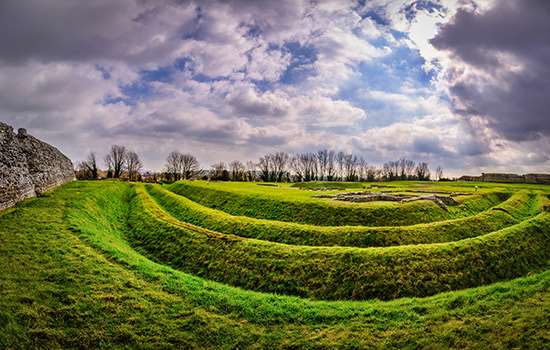
VISIT RICHBOROUGH ROMAN FORT AND AMPHITHEATRE
Richborough is perhaps the most symbolically important of all Roman sites in Britain, witnessing both the beginning and end of Roman rule.
-
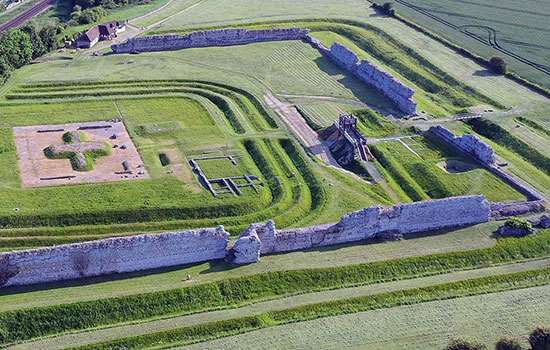
HISTORY OF RICHBOROUGH ROMAN FORT AND AMPHITHEATRE
Read a full history of this key site, which witnessed over 360 years of Roman rule – the entire length of the Roman occupation of Britain.
-
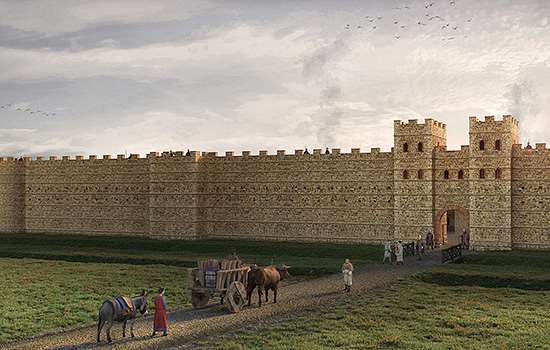
Richborough and the Roman World
Explore a map of the Roman Empire to find out where some of the objects found at Richborough came from, and how they got to Richborough.
-
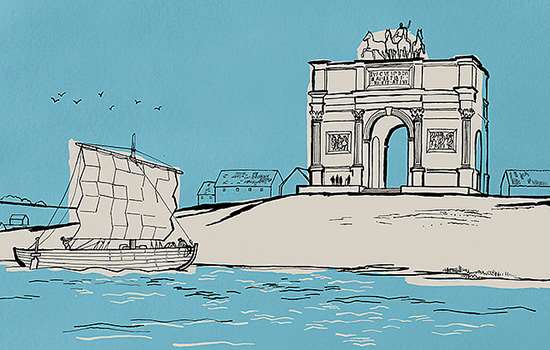
GATEWAY TO BRITANNIA: RICHBOROUGH’S ARCH
The story of Richborough’s monumental arch reveals the great importance of Richborough to the Romans as the gateway to Britannia.

